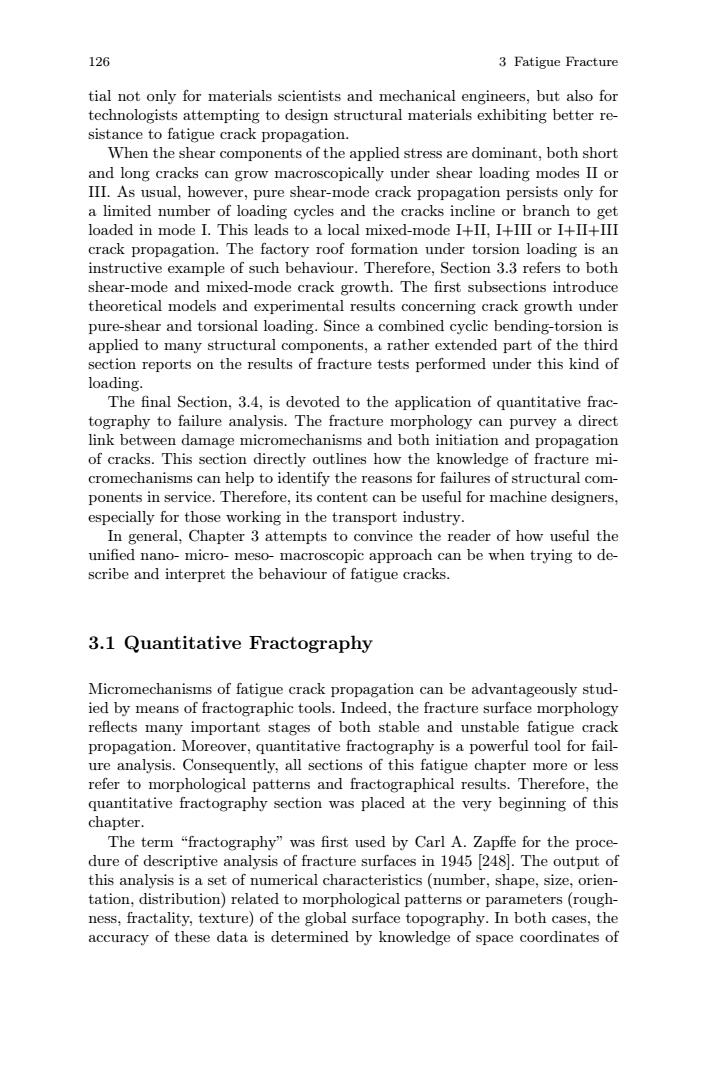正在加载图片...

126 3 Fatigue Fracture tial not only for materials scientists and mechanical engineers,but also for technologists attempting to design structural materials exhibiting better re- sistance to fatigue crack propagation. When the shear components of the applied stress are dominant,both short and long cracks can grow macroscopically under shear loading modes II or III.As usual,however,pure shear-mode crack propagation persists only for a limited number of loading cycles and the cracks incline or branch to get loaded in mode I.This leads to a local mixed-mode I+II,I+III or I+II+III crack propagation.The factory roof formation under torsion loading is an instructive example of such behaviour.Therefore,Section 3.3 refers to both shear-mode and mixed-mode crack growth.The first subsections introduce theoretical models and experimental results concerning crack growth under pure-shear and torsional loading.Since a combined cyclic bending-torsion is applied to many structural components,a rather extended part of the third section reports on the results of fracture tests performed under this kind of loading. The final Section,3.4,is devoted to the application of quantitative frac- tography to failure analysis.The fracture morphology can purvey a direct link between damage micromechanisms and both initiation and propagation of cracks.This section directly outlines how the knowledge of fracture mi- cromechanisms can help to identify the reasons for failures of structural com- ponents in service.Therefore,its content can be useful for machine designers, especially for those working in the transport industry. In general,Chapter 3 attempts to convince the reader of how useful the unified nano-micro-meso-macroscopic approach can be when trying to de- scribe and interpret the behaviour of fatigue cracks. 3.1 Quantitative Fractography Micromechanisms of fatigue crack propagation can be advantageously stud- ied by means of fractographic tools.Indeed,the fracture surface morphology reflects many important stages of both stable and unstable fatigue crack propagation.Moreover,quantitative fractography is a powerful tool for fail- ure analysis.Consequently,all sections of this fatigue chapter more or less refer to morphological patterns and fractographical results.Therefore,the quantitative fractography section was placed at the very beginning of this chapter. The term "fractography"was first used by Carl A.Zapffe for the proce- dure of descriptive analysis of fracture surfaces in 1945 248.The output of this analysis is a set of numerical characteristics(number,shape,size,orien- tation,distribution)related to morphological patterns or parameters(rough- ness,fractality,texture)of the global surface topography.In both cases,the accuracy of these data is determined by knowledge of space coordinates of126 3 Fatigue Fracture tial not only for materials scientists and mechanical engineers, but also for technologists attempting to design structural materials exhibiting better resistance to fatigue crack propagation. When the shear components of the applied stress are dominant, both short and long cracks can grow macroscopically under shear loading modes II or III. As usual, however, pure shear-mode crack propagation persists only for a limited number of loading cycles and the cracks incline or branch to get loaded in mode I. This leads to a local mixed-mode I+II, I+III or I+II+III crack propagation. The factory roof formation under torsion loading is an instructive example of such behaviour. Therefore, Section 3.3 refers to both shear-mode and mixed-mode crack growth. The first subsections introduce theoretical models and experimental results concerning crack growth under pure-shear and torsional loading. Since a combined cyclic bending-torsion is applied to many structural components, a rather extended part of the third section reports on the results of fracture tests performed under this kind of loading. The final Section, 3.4, is devoted to the application of quantitative fractography to failure analysis. The fracture morphology can purvey a direct link between damage micromechanisms and both initiation and propagation of cracks. This section directly outlines how the knowledge of fracture micromechanisms can help to identify the reasons for failures of structural components in service. Therefore, its content can be useful for machine designers, especially for those working in the transport industry. In general, Chapter 3 attempts to convince the reader of how useful the unified nano- micro- meso- macroscopic approach can be when trying to describe and interpret the behaviour of fatigue cracks. 3.1 Quantitative Fractography Micromechanisms of fatigue crack propagation can be advantageously studied by means of fractographic tools. Indeed, the fracture surface morphology reflects many important stages of both stable and unstable fatigue crack propagation. Moreover, quantitative fractography is a powerful tool for failure analysis. Consequently, all sections of this fatigue chapter more or less refer to morphological patterns and fractographical results. Therefore, the quantitative fractography section was placed at the very beginning of this chapter. The term “fractography” was first used by Carl A. Zapffe for the procedure of descriptive analysis of fracture surfaces in 1945 [248]. The output of this analysis is a set of numerical characteristics (number, shape, size, orientation, distribution) related to morphological patterns or parameters (roughness, fractality, texture) of the global surface topography. In both cases, the accuracy of these data is determined by knowledge of space coordinates of